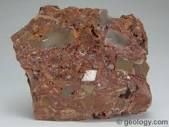Miscellaneous Sedimentary Rocks: (iii) Iron Ore: iron ores of Sedimentary Origin, chiefly hematite Fe2O3
(iv) Flint & Chert: (a) Flint: a fine-grained Sedimentary Rock of quartz and (b) Chert: a Sedimentary Rock of cryptocrystalline (having a microscopic crystalline structure) silica
Continental Formation: They are usually less dense, loosely packed and cemented
Transitional Formation: Sandstone, siltstone, claystone and mudstone belong to this formation
Marine Formation: All the sedimentary rocks formed at sea and ocean floors belong to this formation
Carbonates, silica, quartz, calcite, feldspar, gypsum, clay-minerals (Al.Phyllosilicates: Si2O5, and Iron with alkali metals and alkaline earth metals), amphibole, pyroxene, olivine, dolomite, gypsum and anhydrite (anhydrous CaSO4)
Texture of Sedimentary Rocks mostly depends upon:
Origin of grains (clastic or non-clastic texture)
Size of grains Shape of grains Packing of grains
Fabric of grains (orientation of longer axis of the grains)
Crystallisation trend

Structure of Sedimentary Rocks:
Stratification (layered arrangement),
Lamination (lamination is similar to stratification but it is very thin in thickness usually < 1cm; lamination is a characteristic of a fine-grained ),
Cross-bedding (the above and below layers are not parallel to each other; types of cross-bedding are:
Tabular (when beddings are parallel to each other)
(ii) Lenticular (extreme irregularity in shape of beddings) and
(iii) Wedge Shaped (entangled wedge-shaped beddings)
Graded Bedding: Sediments in beddings are sorted and arranged according to Grain Size – coarsest being at the bottom and finest being at the top – Gravity Settling in the standing water
Surfacial Marks of Sedimentary Rocks: Mud Cracks (in fine-grained sedimentary rocks, there are irregular cracks due to drying of mud)
Rain Prints (conical pitting) Ripple Marks
Classification of Sedimentary Rocks:
Classified on the basis of Mineralogical Constituents
Environment of Deposition Mode of Formation.
Textural and Structural Features
For Practical Purpose, all the sedimentary rocks are classified into two groups:
Clastic
(2) Non-clastic Rocks
(1) Clastic Rocks: Following Wentworth Scale of Particle Size of Sedimentary Clastic Rocks is mostly used by the Sedimentologists for the grading of Clastic Sediments
Wentworth Scale (Named after a US Sedimentologist
C. K. Wentworth in 1912): Based on the particle size only, irrespective of the other characteristics of the sediments
Gravel: When the Grain Size > 2 mm
Boulder: Grain Size > 256 mm (10 inches)
(ii) Cobble: Grain Size 16 to 256 mm
(iii) Pebble: Grain Size 4 to 16 mm
(iv) Granule: Grains size 2 to 4 mm
(b) Sand: Grain Size 1/16 mm to 2 mm. Sand is further sub-divided into three groups:
Course-grained: ½ mm to 2 mm
(ii) Medium-grained: ¼ mm to ½ mm
(iii) Fine-grained: 1/16 mm to ¼ mm
) Silt: 1/256 mm to 1/16 mm. They are further sub-divided into Course-grained, Medium-grained and Fine-grained. The Silt is the major constituent of soil and rock: Shale
(d) Clay: Finer than 1/256 mm. It is major constituent of soils and rocks: Clay-stone and Mud-stone
Finer clays are known as Mud (particle size is mostly around 1 Micrometer {10-6 m} – also known as Micron) and extremely fine / the finest clays are known as Colloid (particle size is mostly around 1 Nanometer {10-9 m} in particle size)
Mud and Colloid are the clay-particles usually suspended in the fine to thick aqueous solution of clay
Non-clastic Rocks: These are also known as Non-detrital Rocks
These are homogeneous in nature
Fine-grained in particle size and
Varying in chemical composition. These are further sub-divided into:
Chemically Formed Non-clastic Rocks
(ii) Ogranically Formed Non-clastic Rocks
Chemically Formed Non-clastic Rocks:
(a) Siliceous Rocks: Silica is the major constituent, examples are Flint, Chert and Jasper (an opaque cryptocrystalline variety of quartz)
(b) Carbonate Rocks: – CO3 is the major constituent; examples are limestone (CaCO3), dolomite [CaMg(CO3)2], magnesite (MgCO3) and siderite (FeCO3)
(c) Ferruginous Rocks: Oxides and hydroxides of iron are the major constituents; examples are limestone, dolomite, magnesite and siderite
(d) Phosphatic Rocks: Phosphoric acid is the major constituent together with the other phosphate compounds
(e) Evaporites: It is a distinct class of Sedimentary Rocks formed by the process of Evaporation; examples are Rock-Salt (Halite), Gypsum, Borate, Anhydrite, Rock-Sulfur and Rock-Nitrate
(ii) Ogranically Formed Non-clastic Rocks: Sedimentary Rocks formed from the remains of the previously living organisms: animals and plants. These organisms might have contributed either directly or indirectly
(a) Carbonate Rocks: Mostly formed from the shells and skeletons of marine organisms
(b) Carbonaceous Rocks: Rich in isolated Carbon; formed from the plant life e.g. Coal
(c) Ferruginous Rocks: Iron carbonate is the major constituent
In fresh water lakes, some bacteria reduce the Ferric Oxide to Ferrous Oxide which finally precipitates as Iron Carbonate
(d) Phosphatic Rocks: Excretion i.e. dropping of some birds (which eat certain fish) contains high contents of phosphate compounds – when accumulated over a period of time, forms a deposit known as Guano which is rich in Phosphate
If there is no change in the physical properties or chemical composition or constitution of a rock, then that rock is (said to be) in equilibrium with its physical and chemical environment
The Three Major Factors which play important role in forming a Metamorphic Rock are: High Pressure, High Temperature and Chemically Active Fluids
When there is change in any of the above given parameters around a rock, then there must be a change takes place in the nature of that rock too
The Changed Rock is known as Metamorphic Rock – now it will be under new set of conditions till there is further change in the surrounding conditions
Factors of Metamorphism: Metamorphic changes in the rock are primarily due the Three Main Factors known as Agents of Metamorphism and the three environments associated with the said three Factors are known as Met. Environments – The Metamorphic Changes are dominant when these factors operate collectively and enormously



